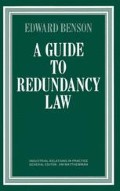Abstract
An employee dismissed for redundancy is normally entitled to– redundancy pay; so one way for employers to resist redundancy pay– claims is to argue that redundancy was not the reason for the– dismissal. The advent of the unfair dismissal provisions brought– about a subtle change in employers’ tactics. It was often in the– employers’ interests to argue that redundancy was the reason for– dismissal, since redundancy is one of the grounds on which a– dismissal may be held fair (see Chapter 13); redundancy pay not only– attracts a rebate from the Redundancy Fund, but is also usually less– than unfair dismissal compensation.–
Access this chapter
Tax calculation will be finalised at checkout
Purchases are for personal use only
Preview
Unable to display preview. Download preview PDF.
Copyright information
© 1985 Edward Benson
About this chapter
Cite this chapter
Benson, E. (1985). Redundancy. In: A Guide to Redundancy Law. Industrial Relations in Practice. Palgrave Macmillan, London. https://doi.org/10.1007/978-1-349-07878-3_3
Download citation
DOI: https://doi.org/10.1007/978-1-349-07878-3_3
Publisher Name: Palgrave Macmillan, London
Print ISBN: 978-1-349-07880-6
Online ISBN: 978-1-349-07878-3
eBook Packages: Palgrave Political & Intern. Studies CollectionPolitical Science and International Studies (R0)

